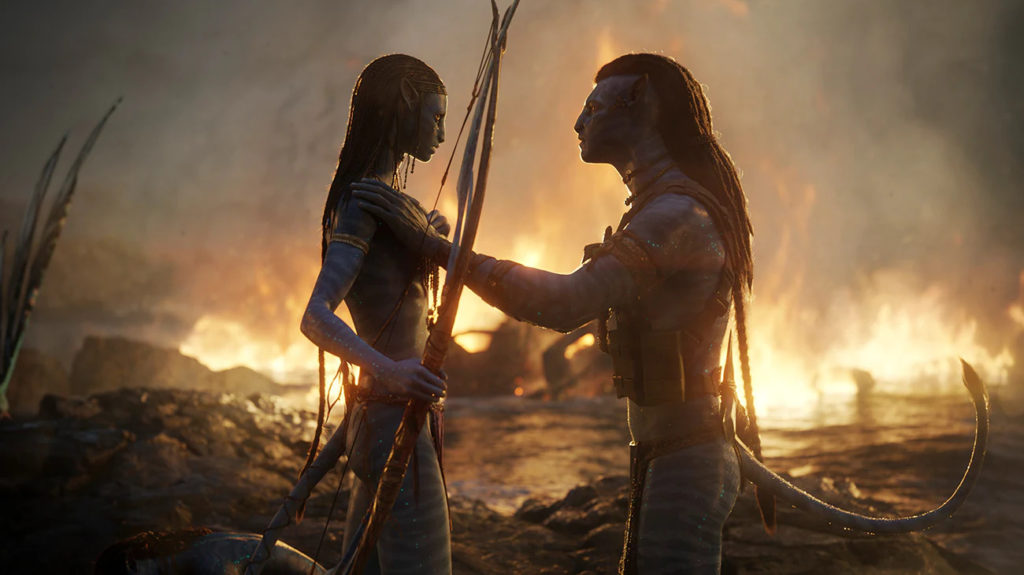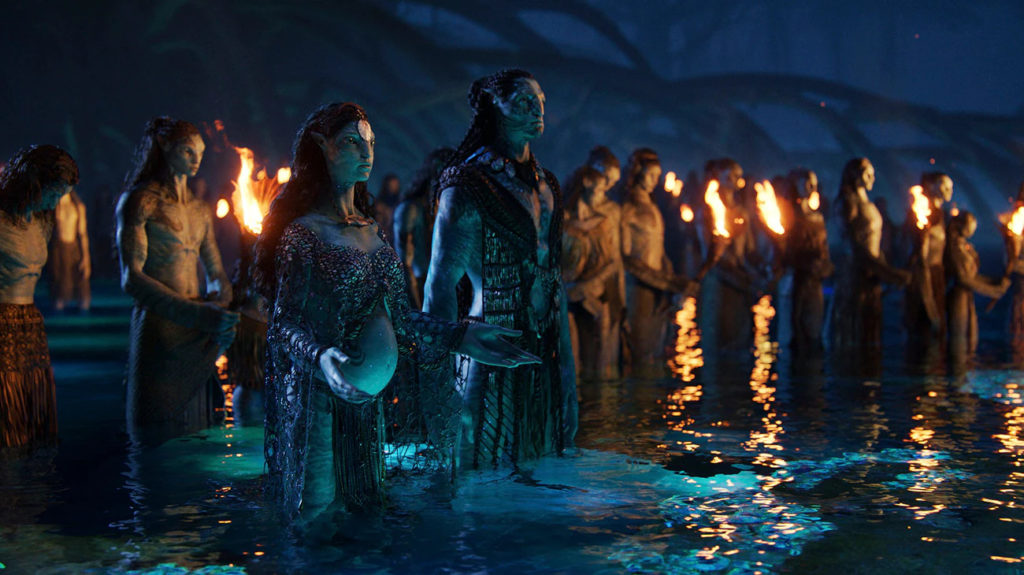Oscars 2023 Q&A: Oscar-nominated alumnus balances realism, fantasy in ‘Avatar’ production design
Jake Sully, played by Sam Worthington (left), trains a young Na’vi how to shoot an arrow. Directed by James Cameron, “Avatar: The Way of Water” continues the story of Sully and Neytiri. The film was nominated for multiple Academy Awards, including Best Production Design. (Courtesy of 20th Century Studios)
By Natalie Glawe
March 9, 2023 8:59 p.m.
The minds behind the inventive world of Pandora are going for the gold this Sunday.
For his work in fashioning the mythical world of “Avatar: The Way of Water,” alumnus Dylan Cole was nominated for the Academy Award for Best Production Design. The ecological design is home to the 10-foot-tall, blue-skinned Na’vi Jake Sully and Neytiri, who desperately attempt to keep their family together in light of ancient threats resurfacing.
Preceding the awards ceremony, Cole spoke with the Daily Bruin’s Natalie Glawe about his experiences and inspirations for designing the Na’vi’s fruitful reality.

[Related: Sundance 2023 Q&A: Producer Maria Altamirano talks ‘All Dirt Roads Taste of Salt’]
This interview has been edited for length and clarity.
Daily Bruin: How did the production design of Pandora differ in “The Way of Water” as compared to the original film?
Dylan Cole: It was a lot of the same philosophies – we just went to a new place. We always try (to) look at things through more of a “National Geographic” lens than that of a science fiction or fantasy film. And so it’s all about what can be plausible, what’s believable. In that way, it was very similar. But of course, we’re going to a very different biome. So in exploring the oceans, we’ve (asked) some basic questions like, “Does water act the same way” (and) “Is water, water?”
Then that’s where the “National Geographic” thing came back, and also working for someone like James Cameron, who knows the oceans very well. He just wanted it to be as real and as familiar as possible. The thing about “Avatar” design is that it’s alien, and it’s fantastical, (but) it’s still very, very relatable. And even though it’s 10-foot blue people, it’s a very human, family story.
To connect with that, you need to be able to connect (with the environment) as well. There’s the environmentalist message about Pandora being an analogy for Earth and how we treat it. If it’s too far different, you’re not going to get that right. So if it’s a bunch of gelatinous, methane clouds and blob creatures that might be truly alien, then no one is going to connect with it.
DB: In crafting Pandora, where did you draw inspiration from?
DC: For the oceans, it was, first and foremost, our oceans. But, there was something ironic that happened in (creating the first) “Avatar” – for a lot of the more exotic plants of the rainforest, we often looked at the oceans. We had plants that were very much like anemones or different pieces of coral. So we, of course, drew from the oceans, but we did look at some more land-based stuff. We might look at like a certain tree or a lichen or something that we can recontextualize or take inspiration from. I always say nature’s the greatest designer, and we can’t hope to do in an afternoon sketch what nature has done over millions of years. And for the cultural stuff, it was really exciting to look at every single bit of Indigenous culture you can find. Looking at art and weaving and taking inspiration from wherever and then putting that in a big melting pot and trying to come up with something new and exciting.
The hardest challenge was (the) Metkayina village in that we hadn’t dealt with Na’vi architecture before. This was the (first legitimate) architecture. As far as inspiration for that, we looked at all sorts of Indigenous cultures all over the world, specifically in the South Pacific and the Indian Oceans and Indonesia, Fiji, Tahiti, New Zealand. Ultimately, it was just talking about tensile architecture with Jim (Cameron) and that it’s this all-connected thing. The whole village is connected, and the walkways really string it together, as do all the structures. What we ended up sort of accidentally discovering and leaning into was that, in plan view, the village was starting to look like a neural network. Their homes or dwellings are sort of like the neurons, and then like the synapses (are) the walkways in between (them). Because in (the first) “Avatar” when you see the network at night with the bioluminescence, it’s very much (like) that neuron network.

[Related: Coming-of-age film ‘Mutt’ highlights human connection in chaos of young adulthood]
DB: Why do you think audiences responded so well to the design?
DC: I think because (of) that mix of relatable but fantastic and that it felt familiar, like the best tropical scuba or snorkeling you’ve ever done. It felt close enough so (audiences) know what that sense is of being in the water and experiencing those colors. But what (audiences are) seeing is so much more and so much more spectacular than what we have on Earth, so it was that relatability factor. If it was too alien, it wouldn’t work.
One thing Jim does is always have us go too far. Let’s go too alien, let’s go too fantastical, (and when) that’s not working, (let’s take) one step back. Doing something on Pandora is hard because there’s no target. It’s just kind of what feels right, to myself and to Jim, and just kind of a gut check of like, “Is this working?”

